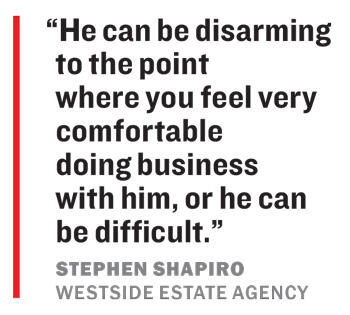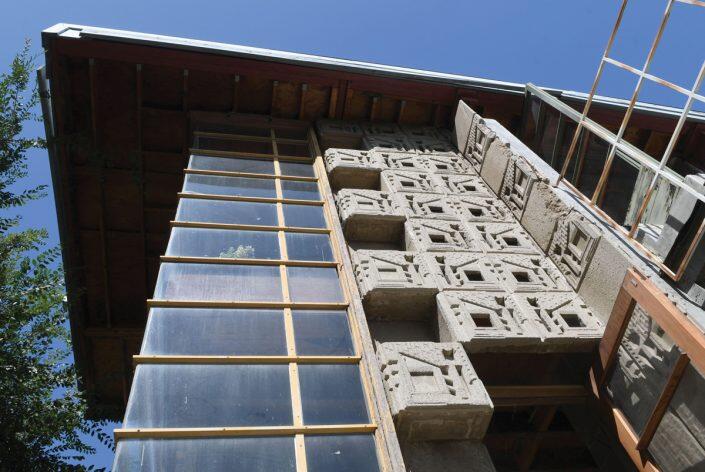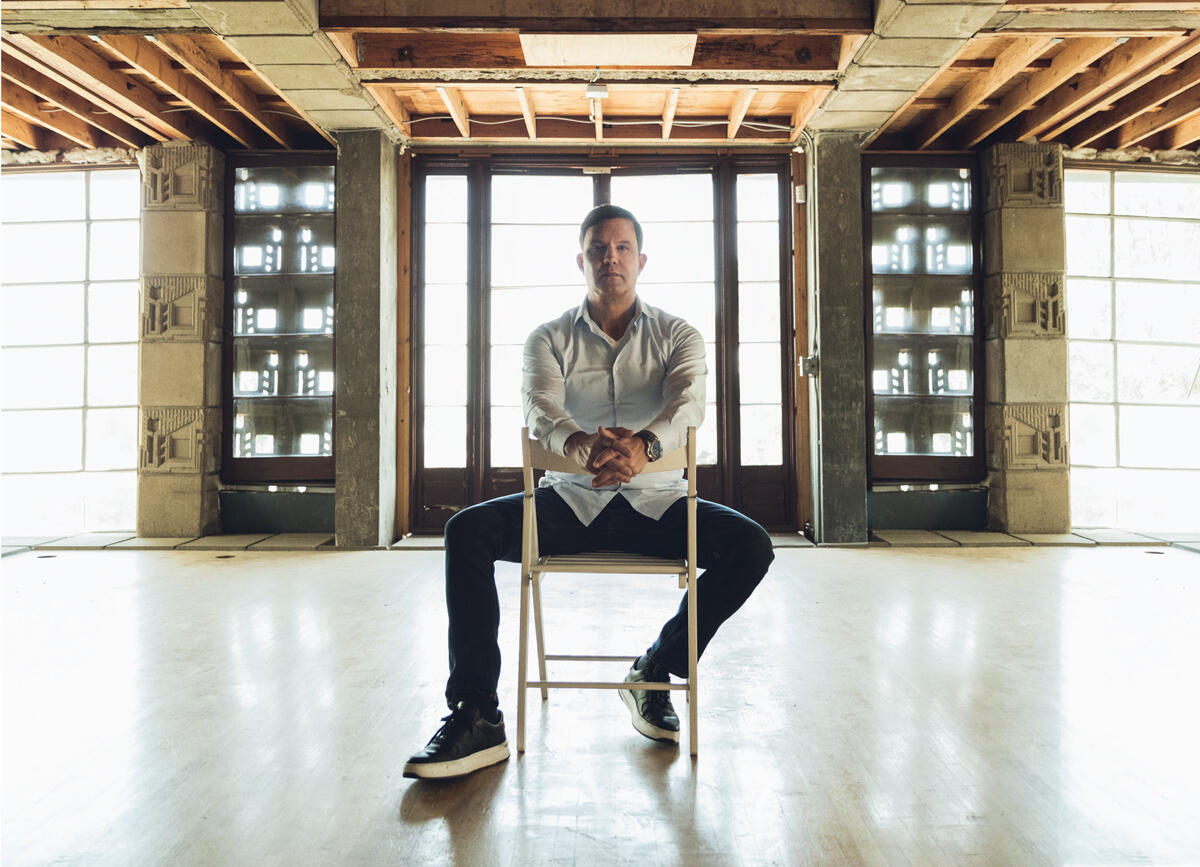Even in Malibu, there was a time when opening an upscale retail center prompted an outcry.
It was the spring of 2009, and the Malibu Lumber Yard had been something of a neighborhood institution for decades. Now, its $25 million reincarnation would keep the name — and its wood theme — but replace the two-by-fours and hammers with gelato and $300 Tory Burch sandals. An open-air deck featured three saltwater aquariums stocked with imported Garibaldi.
Locals — including Dick Van Dyke — slammed the project, fearing it would help turn the beach town into a new Rodeo Drive.
“We’ll be like Aspen and Vail,” another resident told the Los Angeles Times, “with no local businesses serving the community.”
At the time, the developer behind the project, Richard Weintraub, was also renovating another beloved L.A. landmark, the San Fernando Valley’s Sportsmen’s Lodge, which eventually became a high-end retail center. Weintraub is known around L.A. as a prominent investor who sold a restaurant property to Larry Ellison and built some of the city’s top luxury condos and multiple resorts. He’s revisited Malibu to develop some of the enclave’s most notable homes, including La Villa Contenta, a six-acre estate known for its 2,500-year-old lion-head sculpture and bejeweled Romanesque natatorium. (A few years ago, Jay-Z and Beyoncé rented the estate for $400,000 per month; the next year Weintraub sold it for nearly $50 million.)
All of which made it somewhat surprising when, about 15 minutes into a recent interview, he segued into a lament over L.A.’s gaping lack of affordable housing.
“Eagle Rock, Atwater Village, Frogtown — these are all like million-dollar places now that five years ago were $250,000, $300,000 places,” he said. “I worked seven years on the L.A. River and we saw all these challenged areas, and now they’re — you know, the price in South Gate, which is a challenged area, is more than a magnificent home in parts of Ohio.”
Weintraub was speaking from his airy Santa Monica office, where a marble coffee table in the lobby displayed a bulky silver marquette of a bear sculpture by Frank Gehry — an architectural icon largely associated with L.A. The walls of the room were lined with subway drawings by Keith Haring, an essential New York artist. Weintraub was thinking about both cities.
“What makes Los Angeles so dynamic right now,” he said, “is the multicultural experience that one gets here, but also there still are some quasi-affordable places to live, where New York lost all of that…
“New York became so good” — and the rents so high, first in Manhattan and then Brooklyn and even Hoboken — “that it became impossible to be a unique person, a purple person, and just say, ‘Well I’m from the Midwest and people think I’m a weirdo there, but I’m going to get out of here, I’m going to go to New York.’ … And I really don’t want to see that happen to Los Angeles. But it could.”
 Weintraub was born into a successful professional family, and he made his own fortune decades ago. Yet he’s always considered himself one of the purple people in his own way. It’s a description that helps explain his remarkably varied development career, in which he’s pursued everything from luxe Westside projects to an Inland Empire mall overhaul to a historic cathedral renovation in Downtown L.A. (“He’s a renaissance man,” said the broker Aaron Kirman.) It also helps explain Weintraub’s latest project: a plan to return the Freeman House, a run-down Frank Lloyd Wright home, to its past glory as an intellectual and artistic salon.
Weintraub was born into a successful professional family, and he made his own fortune decades ago. Yet he’s always considered himself one of the purple people in his own way. It’s a description that helps explain his remarkably varied development career, in which he’s pursued everything from luxe Westside projects to an Inland Empire mall overhaul to a historic cathedral renovation in Downtown L.A. (“He’s a renaissance man,” said the broker Aaron Kirman.) It also helps explain Weintraub’s latest project: a plan to return the Freeman House, a run-down Frank Lloyd Wright home, to its past glory as an intellectual and artistic salon.
Weintraub pointed out that Wright — who was raised on a Wisconsin farm but nurtured grand ambitions and led a notoriously troubled private life, marked by murder and tragedy — was, in his time, “always kind of a pioneer and an outsider.”
“You walk into that house and it’s got incredible energy,” he said. “And it’s just crying for someone to bring it back to life.”
Valley boy
Weintraub is in his mid-50s but looks younger in a very L.A. kind of way, with full cheeks and smooth, nearly unlined skin. Multiple people contacted for this piece described him as “a great guy,” a hollow description that also seems true:
He seemed skeptical and reserved at the start of our first interview, then proceeded to happily riff for two hours on everything from the bureaucracy holding up California housing (“We just keep throwing money at things and the problems aren’t changing”) to the importance of architectural function in places like museums (“Our brains tell us right away what makes us feel comfortable”) to antisemitism (“I don’t get it … I think we all have so much in common.”)
“He’s a very charming guy,” said Stephen Shapiro, the co-founder of Westside Estate Agency. “He can be disarming to the point where you now feel very comfortable doing business with him, or he can be difficult … He has a way of getting you to agree to what he wants; let’s put it that way.”
Weintraub grew up in Sherman Oaks, the son of a surgeon father and politically involved mother, Roberta Weintraub, who led the San Fernando Valley’s 1970s anti-busing movement and served four terms as president of the L.A. school board. The family would be scarred by trauma — Richard was a teenager when his only sibling, a brother named Michael, died in a car crash — but Weintraub’s early surroundings were otherwise idyllic, he said, typified by robust school life and kids riding bikes through safe, tree-lined streets.
“Did you ever see the show ‘The Wonder Years?’” he said. “The Valley was exactly that.”
Still, Weintraub saw himself as a “very weird” adolescent who was more comfortable around adults than his own peers.
“I wanted to make a lot of money,” he said. “Not because I wanted to be rich, but because I wanted to be independent.”
Already fascinated by architecture, he went to work at 13 for an uncle who owned commercial properties in DTLA. He then did a stint working for the slick Democratic state senator and developer Alan Robbins, and then worked for George Moss, a commercial developer who made a fortune building along freeway exits. Weintraub was still a baby-faced teenager when he took on his first development, renovating a house in Benedict Canyon around the same time he decided to get his real estate license.
“Because I figured anyone can sell a house,” he said. “Like, what’s the big deal?”
Soon, he was knocking on the front door of a stately brick Georgian in Beverly Hills, where the owner — a friend of Weintraub’s grandmother — was bewildered to find an apparent child trying to convince her to give him the listing.
“You look like you’re 12 years old,” Weintraub remembers the woman telling him. “You can’t sell a house.”
He later sold it for around $3 million, he said — above ask.
Weintraub also faced plenty of controversy. He was barely 30 when his Californian on Wilshire project, a high-rise luxury condo, came before the city council for approval. The project was located in the city’s 5th District, where his mother, Roberta Weintraub, had recently lost the council race to Mike Feuer, the future city attorney and mayoral candidate.

The exterior of the Freeman House
Feuer opposed Weintraub’s project, but Roberta still had plenty of sway on the council — leading to insinuations of nepotism when councilmembers, one of whom mentioned having seen “Richie Weintraub grow and develop since he was a young boy,” decided to approve the build.
“I’m not going to try to conjecture as to what might be motivating my colleagues on this,” Feuer fumed at the time. “But the outcome is grotesque.”
Weintraub still remembers the battle, and calls the nepotism insinuation ridiculous.
“It doesn’t feel good,” he said of those encounters, but the fights also taught him something. “It’s a chess game,” he said. “Development is a chess game.”
Bright lights, dark city
Many of Weintraub’s projects, or attempted projects, appear to have little in common.
In the late 1990s, he pursued a quasi-spiritual camping resort, complete with Mongolian-style yurts, tucked away in the Santa Monica Mountains. A few years later, he dived into the overhaul of a fashion mall in the desert city of Indio. He’s bought a business park in Woodland Hills, a creative loft in West Hollywood and a historic hotel in Palm Springs.
He’s best known for his luxe Malibu residential projects, including La Villa Contenta and a 7,200-square-foot beachside mansion he sold in March to the billionaire venture capitalist Marc Andreessen for $45 million. At times, his plans in the wealthy enclave have proved malleable: In late 2014, amid a prolonged permitting saga for an intended resort on 28 acres near Pepperdine University, Weintraub announced he and his partner would instead pursue a high-end ecumenical cemetery.
“I think it was driven by money,” said the developer Scott Gillen, who fought Weintraub on the project because Gillen was planning his own compound across the street, “and because they were frustrated because they couldn’t put up a hotel.”
“It was definitely fiscally driven,” Weintraub said recently, but also an attempt to upend conventional cemetery architecture. The idea was for a minimal, scenic space that resembled more of a garden than a graveyard, where visitors would locate burial sites by GPS rather than tombstones. (The plan eventually fell through.)
“Everything’s very site-specific,” Weintraub said more generally of his development philosophy. “But then again, I guess as a developer, sometimes you get to be the judge and jury.”
Weintraub’s plans for the Freeman House are decidedly not fiscally driven. Wright designed the Mayan-themed home, part of the architect’s “textile block” collection — in which he created an entirely new building style by stacking thousands of patterned concrete blocks together to form walls — in the early 1920s. The three-level house is surrounded by lush landscaping and built into a steep hilltop overlooking Hollywood.
For decades, it served as a cultural hub for an emerging Los Angeles. Clark Gable was an early tenant, and guests included the architect Richard Neutra and the dance pioneer Martha Graham. In 1953, a black-and-white living room photo taken by Julius Shulman immortalized the place, and in the 1980s it was deeded to USC. By then, decades of water damage and block corrosion had taken a toll. Several years later, so did the Northridge earthquake. Weintraub paid $1.8 million for the property in February and will likely spend at least that in renovations, with no plan to recoup the costs.
“It was that photo,” he said. He had seen it as a kid, he explained, and then came across it again a decade ago, which sparked an obsession.
“L.A.’s a dark city,” he continued. “It’s all full of brightness and light and optimism, but really underneath it is drugs and prostitution and murder and mafia and Hollywood — I love that. This house, this whole look, I think is the epitome of the symbolism of that.”
Weintraub was sitting in the salon depicted in the photo, where the bird’s-eye view of Hollywood was the same but a dark tarp was laid over the floor; in the middle of the room was a large table holding stacks of literature and architectural drawings. He had just led a comprehensive tour during which he elaborated on his intentions: He plans to return nearly everything to its original 1920s form, restoring the museum-worthy furniture and the mitered corner glass windows and the white oak kitchen. Then he’ll proceed with the real plan: transforming the house into a kind of artist-in-residence where visiting professors or painters or musicians can foster creative ideas while actually living — affordably — in the heart of L.A.
The idea is to create a modern-day homage to the Freemans’ bohemian salons, and ignite the kind of freewheeling artistic spirit, Weintraub emphasized again, that needs saving.
“I think we can do that here,” he said, standing next to a cracked concrete block. “I know we can do that here.”

